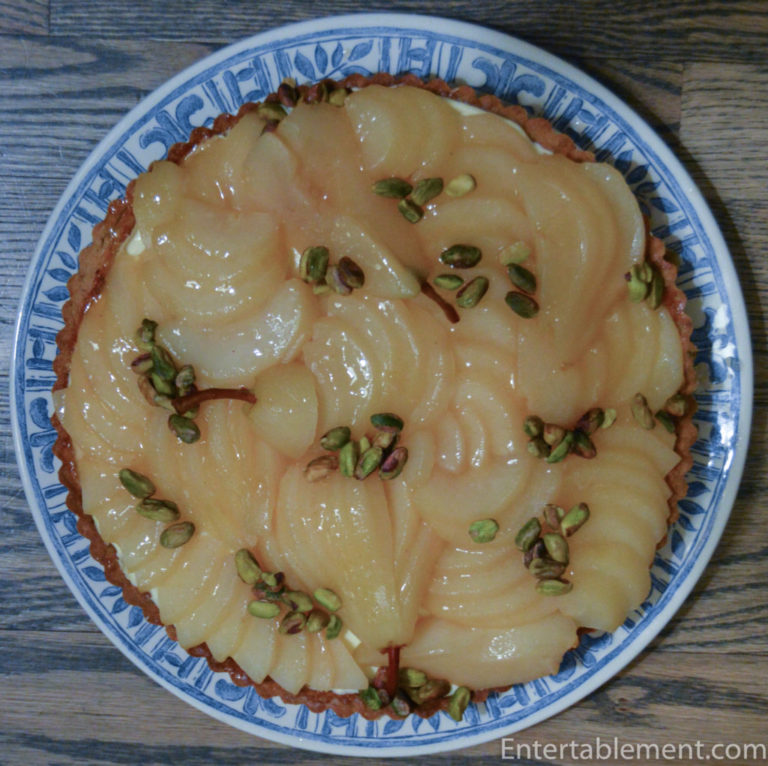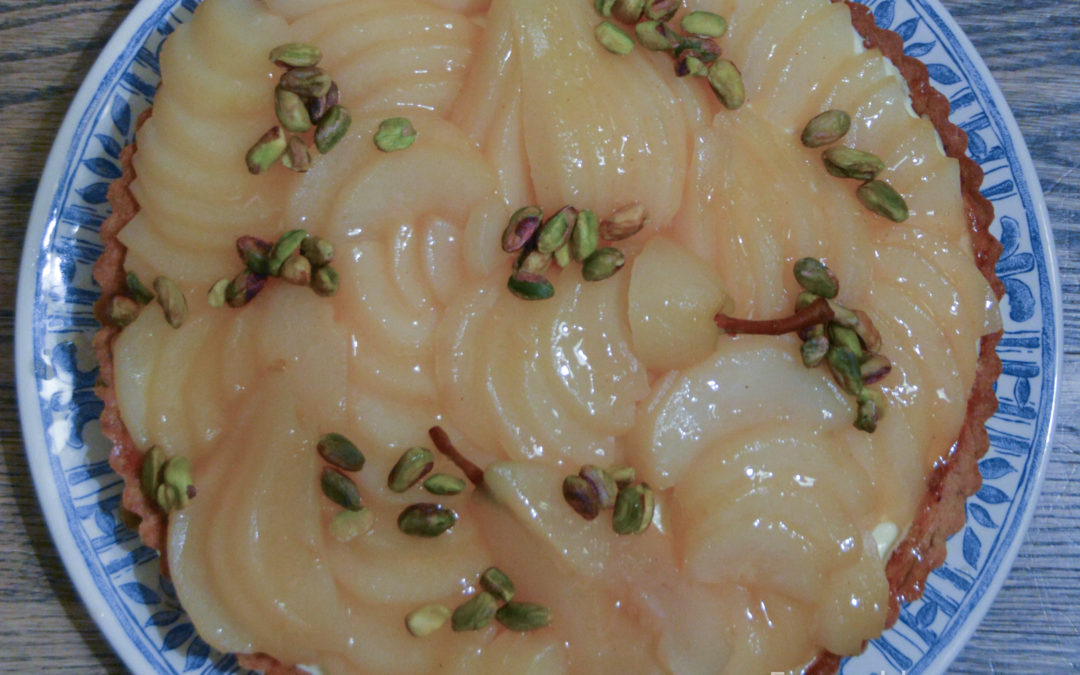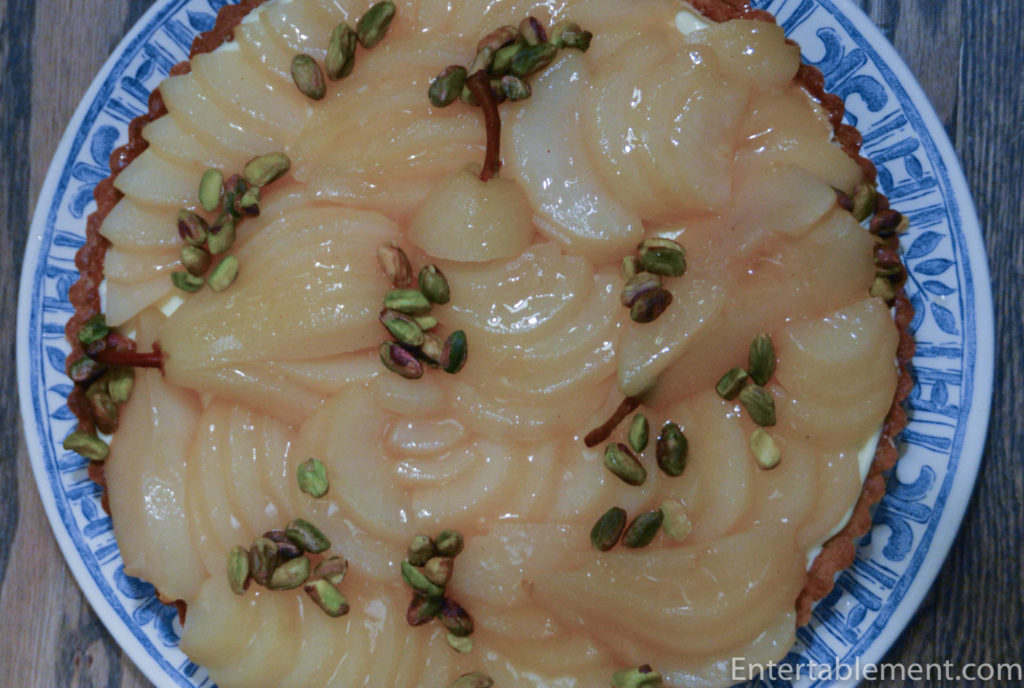Earlier this month, we invited some friends over for dinner at the Cape, and I wanted to make a dessert that was somewhat virtuous but with a hint of decadence. (The nearly universal donning of the January culinary hair-shirt gets a bit depressing). I thought about poached pears, which would have been simply virtuous, and then came across this tart recipe in Fine Cooking from the October/November 2015 issue.
Now doesn’t that look a lot more appealing than plain old poached pears?
I played around with the recipe; reworked the instructions, both clarifying and rearranging them into a more logical order (at least to me). I used mulling spices instead of the cinnamon stick and star anise to poach the pears, and I left out the cardamom because I just don’t like its taste. To be on the safe side, I poached more pears than called for, in case I made a mess of things while slicing them, and I didn’t have many slices leftover (I used an 11″ tart pan, which might explain it). Lastly, to line the tart shell, I substituted dark chocolate for the white; while the white might have been more aesthetically appealing, I thought the dark provided more oomph.

Poached Pear Pistachio Tart
A stunningly beautiful dessert. Its fruit-forward ingredients make it healthyish, but it’s got a touch of decadence with the luscious pastry cream filling and dark chocolate lining.
Ingredients
For the poached pears
- 1 750-ml bottle of dry white wine
- 100 g (3.5 oz or 1/2 c) granulated sugar
- 1 tbsp mulling spices
- 2 (3-inch) strips lemon zest
- Juice of 1 lemon
- 900 g or 2 lb peeled and halved firm-ripe pears (I used Bosc)
For the crust
- 250 g (8 3/4 oz or a scant 2 c) all-purpose flour; more for dusting
- 100 g (3 1/2 oz. or 3/4 c plus 2 tbsp) confectioners’ sugar
- 50 g (1 3/4 oz) pistachios
- 170 g (6 oz or 12 tbsp) cold unsalted butter, cut into 1/2-inch pieces
- 1/4 tsp kosher salt
- 2 large eggs, 1 separated
- Cooking spray
- 28 g or 1 oz melted dark chocolate
For the filling
- 1 c milk
- 50 g (1 3/4 oz or 1/4 c) granulated sugar
- 1/2 vanilla bean or 1/2 tsp pure vanilla extract or paste
- 1 large egg
- 1 large egg yolk
- 1 1/2 tbsp cornstarch
- 15 g (1/2 oz or 1 tbsp) unsalted butter, cut into 1/2-inch pieces
- 175 ml or 3/4 c whipping or heavy cream
- 33 g (1 oz or 1/4 c) confectioners’ sugar
For finishing the tart
- 1/4 cup apricot or apple jelly (I used Stonewall Kitchen’s cinnamon apple jelly)
- 2 tbsp water or white wine
- Whole pistachios, for garnishing
Instructions
Poach the pears
- In a deep, narrow 4- to 5-quart pot, combine the wine, sugar, lemon zest and juice. Stir to distribute the sugar. Put the mulling spices into a disposable tea bag or metal tea ball and add to the pot. Add the pears. Bring to a simmer over medium heat and cook for 5 to 10 minutes.
- Lower the heat and cover the pears with a circle of parchment and a plate to keep them submerged. Continue cooking until the pears give just a little resistance when pierced with a paring knife. (They will continue to cook a little more as the liquid cools.) Let cool completely, submerged in the liquid, then chill in the fridge for at least 4 hours. About half an hour before you’re ready to assemble the tart, remove the pears from the liquid and drain on paper towels. Remove the the cores with a small spoon.
Make the dough
- In food processor, pulverize the pistachios to make pistachio meal. Add the flour, sugar, butter, and salt. Pulse until the butter begins to break up, (about 15 pulses). Continue to pulse until the mixture looks sandy with butter pieces the size of tiny pebbles. Add the whole egg and egg yolk (reserve the remaining white). Pulse until incorporated, and the dough pulls away from the sides of the bowl (about 15 seconds). Do not overprocess or the dough will be tough.
- Determine the size of the tart pan you will be using. You’ll need about half the dough for a 9 1/2″ pan and up to three quarters of it for an 11″ pan. Divide the dough accordingly, pressing into disks about 4 inches across. Wrap them in plastic and refrigerate the one you will be using for at least 3 hours and up to 24 hours. (Freeze the other disk for up to a month; thaw in the refrigerator before using.)
Make the pastry cream
- Combine the milk and 2 tbsp of the sugar in a 3- to 4-quart saucepan. If using a vanilla bean, split it and scrape the seeds into the milk, then add the pod. Bring to a boil, stirring occasionally, about 5 minutes. Remove the vanilla bean pod, if using.
- Meanwhile, in a medium heatproof bowl, whisk the remaining 2 tbsp sugar with the egg, egg yolk, and cornstarch until smooth, about 1 minute. Whisk half of the hot milk into the egg mixture until combined. Off the heat, whisk the contents of the bowl back into the remaining milk in the saucepan.
- Cook over medium heat, whisking constantly, until the mixture starts to thicken. Continue to cook for another minute or two, whisking constantly. Off the heat, whisk in the butter, vanilla paste or extract, if using. Transfer the mixture to a medium sized glass bowl and cover with plastic wrap pressed onto the surface of the pastry cream to prevent a skin from forming. Refrigerate until cold (at least 2 hours and up to 3 days).
Shape and bake the crust
- Lightly flour a work surface and a rolling pin. Spray a 9-1/2- to 11-inch fluted tart pan with a removable bottom with cooking spray.
- Working quickly, roll the dough disk into a 1/8-inch-thick round. Transfer the dough to the tart pan and gently coax it into the pan, allowing the excess dough to hang over the sides. Roll the rolling pin over the top of the pan to cut off the excess dough. Patch any tears or cracks with the scraps. Refrigerate the crust for at least 20 minutes or freeze for 10 minutes. Meanwhile, position a rack in the center of the oven and heat the oven to 350°F Convection or 375°F.
- Line the crust with parchment paper and fill it with beans or pie weights. Bake until the edges are golden (18 to 20 minutes). Carefully remove the weights and paper. Bake until the center of the crust looks dry and is just beginning to colour (3 to 5 minutes).
- Beat the reserved egg white. Brush the inside of the crust with some of the egg white (you won’t need it all) and return the crust to the oven until the egg white has dried (about 2 minutes). This prevents the crust from getting soggy once you add the filling. Cool completely on a rack.
- Brush the interior of the cooled crust with the chocolate. Let it set for a few minutes in the fridge before proceeding.
Fill and top the tart
- In the bowl of a stand mixer, beat the cream to soft peaks. Gently add the confectioners’ sugar, then beat to stiff peaks. Transfer the cream to another bowl. Add the pastry cream to the stand mixer bowl and beat to soften and smooth it. With a large spatula, fold the whipped cream into the softened pastry cream until thoroughly combined. Fill the crust with the crème légère, evening it out with a small offset spatula. Refrigerate for at least 1 hour before topping with the pears.
- Consider your arrangement for the pears. The tart filling is soft, and you’ll need to work quickly while the filling is cold and firm. Because it’s hard to move the pears once they’re on the filling, you may want to practice your pattern on an empty sheet pan before placing it on the tart. I sliced some of the pears lengthwise and others widthwise. Have fun with it!
- Put the jelly and water or wine in a small saucepan. Simmer and whisk together to form a smooth glaze. Allow to cool slightly. Brush it on the exposed pears, being careful not to pull up the cream filling from below. Refrigerate the tart until ready to serve. Just before serving, garnish the tart with the pistachios. Serve cold, within 6 hours of topping.
Nutrition
- Serving Size: 12
The tart was a big hit; no leftovers on anyone’s plate, which I take as a sign of success. It cut easily and kept its shape quite well. The crust was nice and crisp without being tough. The pears were probably a touch more firm than I would have liked, but better to err on that side than being too soggy.
I’m sharing this post with Between Naps on the Porch.




